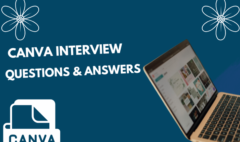Introduction to Digital Marketing Question and Answer
Introduction to Digital Marketing Question and Answer
1. What is Digital Marketing?
Digital Marketing is promoting products or services online using platforms like Google, Facebook, Instagram, email, and websites.
2. What are the types of Digital Marketing?
- SEO (Search Engine Optimization): Making your website appear in Google search results.
- Social Media Marketing (SMM): Promoting on Facebook, Instagram, etc.
- Content Marketing: Sharing blogs, videos, and useful content.
- Email Marketing: Sending offers and updates through emails.
- PPC (Pay-Per-Click): Paying for ads to appear on Google or other sites.
3. How is Digital Marketing different from Traditional Marketing?
Digital Marketing |
Traditional Marketing |
| Uses the internet (Google, social media). | Uses TV, radio, or newspapers. |
| Can target specific people. | Targets everyone. |
| You can track results. | Hard to know results. |
Example:
A company can run Instagram ads to reach young people (digital marketing). But a newspaper ad (traditional marketing) reaches all kinds of people.
4. Why is Digital Marketing important?
You can reach more people easily.
It costs less than TV or newspaper ads.
You can see what’s working through reports.
It works 24/7, even when you sleep.
5. What is a target audience in Digital Marketing?
Target audience means the group of people you want to sell your product to.
Example:
If you sell baby clothes, your target audience is parents with babies.
6. What is SEO, and why is it important?
SEO means improving your website so it shows up on Google when people search for something. It’s important because more people will visit your website.
Example:
A pizza shop in Delhi wants to rank for “best pizza in Delhi” to get more customers.
7. What is the role of social media in Digital Marketing?
Social media helps you connect with people, show your products, and run ads. It’s a great way to talk to your customers.
Example:
A bakery posts cakes on Instagram and runs ads for “custom cakes” to get more orders.
8. What tools are used in Digital Marketing?
Google Analytics: For website traffic and behavior analysis.
SEMRush/Ahrefs: For SEO and keyword research.
Hootsuite: For managing social media campaigns.
Mailchimp: For email marketing.
Google Ads: For running PPC campaigns.
9. What is a Call-to-Action (CTA)?
CTA is a short message that tells people what to do, like “Buy Now” or “Sign Up.”
10. What is the customer journey in Digital Marketing?
The customer journey is the steps a person takes before buying something:
Awareness (learning about the brand).
Consideration (comparing options).
Decision (making a purchase).
Retention (becoming a loyal customer).
Example:
A customer sees an ad for a smartphone on YouTube (awareness), compares features on the website (consideration), buys it online (decision), and receives loyalty discounts for future purchases (retention).
11. What is PPC in Digital Marketing?
PPC (Pay-Per-Click) is when you pay money to show ads on Google or other platforms. You only pay when someone clicks on your ad.
12. What is Content Marketing?
Content Marketing is creating and sharing useful content (like blogs, videos, or posts) to attract customers.
13. What is Email Marketing?
Email Marketing means sending emails to people to share updates, offers, or new products.
14. What is a Landing Page?
A Landing Page is the page where people go after clicking on your ad or link. It’s designed to make them take an action, like signing up or buying.
15. What is Affiliate Marketing?
Affiliate Marketing is when you pay people (affiliates) to promote your product. They earn money for every sale they bring.
16. What is the difference between SEO and PPC?
SEO: Free, but takes time to show results.
PPC: Paid, and results come faster.
Example:
An SEO blog for “best laptops” takes months to rank, but PPC ads for laptops appear instantly.
17. What is Google Analytics?
Google Analytics is a tool to check how many people visit your website, what they do, and where they come from.
18. What is the difference between a blog and a website?
A blog is part of a website and shares articles or news.
A website has multiple sections like blogs, services, and products.
19. What is Influencer Marketing?
Influencer Marketing means working with popular people (influencers) to promote your product.
20. What is Retargeting in Digital Marketing?
Retargeting shows ads to people who already visited your website but didn’t buy anything.
21. What is a Marketing Funnel?
A marketing funnel shows the journey of a customer from knowing about a product to buying it. The steps include Awareness, Interest, Decision, and Action.
Example:
A person sees an ad for a mobile phone (Awareness), reads reviews (Interest), checks the price (Decision), and buys it (Action).
22. What is the difference between B2B and B2C Marketing?
B2B (Business to Business): Marketing to other businesses.
B2C (Business to Consumer): Marketing directly to individual customers.
23. What is Mobile Marketing?
Mobile Marketing means promoting products through mobile devices using apps, SMS, or mobile-friendly websites.
24. What is Keyword Research?
Keyword research is finding the words people type into search engines so you can create content around them.
25. What is a Blog, and how does it help in Digital Marketing?
A blog is an article or post written to provide useful information and attract visitors to your website. Blogs help by improving SEO and increasing website traffic.
Example:
A travel company writes a blog on “Top 10 Places to Visit in India” to attract more tourists.
26. What is Social Media Optimization (SMO)?
SMO is improving your social media profiles and content to increase visibility and engagement.
27. What is Conversion Rate?
The conversion rate is the percentage of people who take a desired action (like signing up or buying).
Example:
If 100 people visit your website and 10 buy something, your conversion rate is 10%.
28. What is User-Generated Content (UGC)?
UGC is content created by users or customers, such as reviews, photos, or videos.
Example:
A customer posts a photo of themselves wearing your brand’s clothes on Instagram.
29. What is the importance of Analytics in Digital Marketing?
Analytics helps you track the performance of campaigns, understand customer behavior, and improve strategies.
30. What is A/B Testing in Digital Marketing?
A/B Testing is comparing two versions of something (like ads, emails, or websites) to see which works better.
Example:
An online store creates two versions of an ad—one with “Buy Now” and another with “Shop Today”—to find out which gets more clicks.














